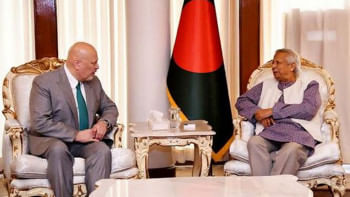Challenges remain despite sweet problem

"I think our strengths have been our all-rounders and our bowling department. Having said that, I think our batting department is also very good. I think we've got a good balance in our team, especially with five or six all-rounders who can bowl and bat. Our fast bowlers have been doing an incredible job at the moment and as usual, our spinners are our strength. If they can put up their hands in few matches, hopefully we can have good results."
A fascinating but by no means unproblematic trend in Bangladesh cricket, one that has existed for some time, is how players make their back into the national side because others have performed badly. As in a game of musical chairs, players circle back into the team, but the problem in terms of team selection is how many players return without having performed in order to stake a claim.
The recent two T20I series against Zimbabwe away and Australia at home, however, have seen a number of players perform, which gave 'competition for places in the side' real meaning. Thus, the Tigers' team management might be facing a sweet problem, an unfamiliar one, especially in the shortest format where the Tigers have historically been found wanting.
The recent injection of youth to the T20 outfit has given the team a better outlook in the shortest format. There is depth in the lower middle-order with the likes of Afif Hossain, Shamim Hossain and Nurul Hasan bolstering the batting order.
Problems still remain at the top, with Soumya Sarkar remaining inconsistent throughout the Australia series while Mohammad Naim, despite getting a few good starts, yet to deliver big. Despite that, the fact remains that the Tigers had a winning combination.
With the likes of Mushfiqur Rahim, Tamim Iqbal and Liton Das returning to the side, the question remains how the Tigers balance the team ahead of the New Zealand series and with an eye on the T20 World Cup in October.
Mushfiqur and Tamim are automatic choices but does that mean someone else fit for the format is excluded? Nurul looked confident behind the stumps in the recent series but the role of wicketkeeper means he is constantly in competition with Mushfiqur and Liton.
The return of the experienced players also means changes in the batting order. Skipper Mahmudullah Riyad had promoted himself up the order in Mushfiqur's absence but that will perhaps not be on the cards with Mushfiqur and Tamim returning. Afif has also already made a good case of batting higher than the position that he has been prescribed so far in T20s.
Nazmul Abedeen Fahim, a mentor to many of the national team stalwarts, analysed the scenario for The Daily Star thusly: "In the T20 format, skill does not matter as much as the ODI format. Power is an issue in this format and we have suffered due to that previously. However, Afif, Shamim and Nurul have given us depth and intention from the top-order that will have to be aggressive going forward," he analysed.
"You cannot get the desired total by just playing a long innings in this format. As long as you are out there, there is a demand to stay aggressive," he dictated.
The modus operandi, according to one of the best minds in Bangladesh cricket, is to select squads with situations and roles in mind. "You have to select the squad according to roles. It's not about picking the best players; it's about picking the players that are going to be most effective.
"It's not about the names. For instance, Nurul knows the demand of batting in last five overs in this format better than Tamim or Shakib [Al Hasan]."
Despite the sweet selection headache, challenges remain.
The bowling department has added dynamism with Mahedi Hasan and Mohammad Saifuddin while Mustafizur Rahman and Shoriful Islam were able to contain Australia on home soil.
However, the wickets at the World Cup will be different, Fahim reminded. "Even with our bowling doing well, we have to chase down 170 or 180 in regular wickets. Rather than our bowlers becoming overconfident now, perhaps it would be better to gain experience of regular wickets also with the T20 World Cup in mind," he concluded.
A healthy competition can raise performance levels while the team think tank can build on how to raise the squad's level for the upcoming challenges.
The return of Tamim and Liton means there is a competition at the top for Soumya and Naim. Soumya's position in the batting order is still an issue and even as he struggled in the series against Australia, when faced with true wickets, he provides an option at the top due to his ability to score quick runs and take advantage of the early overs. If an aggressive mindset can be introduced at the top, it will be supported by the stable middle order of Shakib, Mushfiqur and Mahmudullah. Currently, the lower middle-order has healthy competition and Saifuddin has suitable skills for the format. Mahedi as well has been used at the top-order in recent series and that flexibility allows for some dynamism in the batting order. With the T20 World Cup coming in two months, the five-match T20I series at home against the Kiwis provides the team management an opportunity to work out how to balance the side. While management's focus would remain on fine-tuning the rational permutations in the batting order, the challenges for the bowlers cannot be overlooked, particularly on tracks that produce more runs than what was on offer in the recent series against Australia. While the sweet selection problem gives added advantage, the onus will now be on getting the planning right in order to further improve the team's capabilities in the T20 format.


 For all latest news, follow The Daily Star's Google News channel.
For all latest news, follow The Daily Star's Google News channel. 



Comments